We often take the value of pennies for granted. Sure, they may be the lowest sum of money, but did you know that older pennies can be worth a small fortune?
Take the 1985 penny as an example – although they are still found in circulation today, a wide variety of types and errors can utterly transform their value in the eyes of collectors.
So is your prized 1985 penny worth hundreds, or even thousands, of dollars? This article will explore everything there is to know about the 1985 penny’s value. We’ll also show auction examples to give you an idea of the price range they can yield.
1985 Penny Details
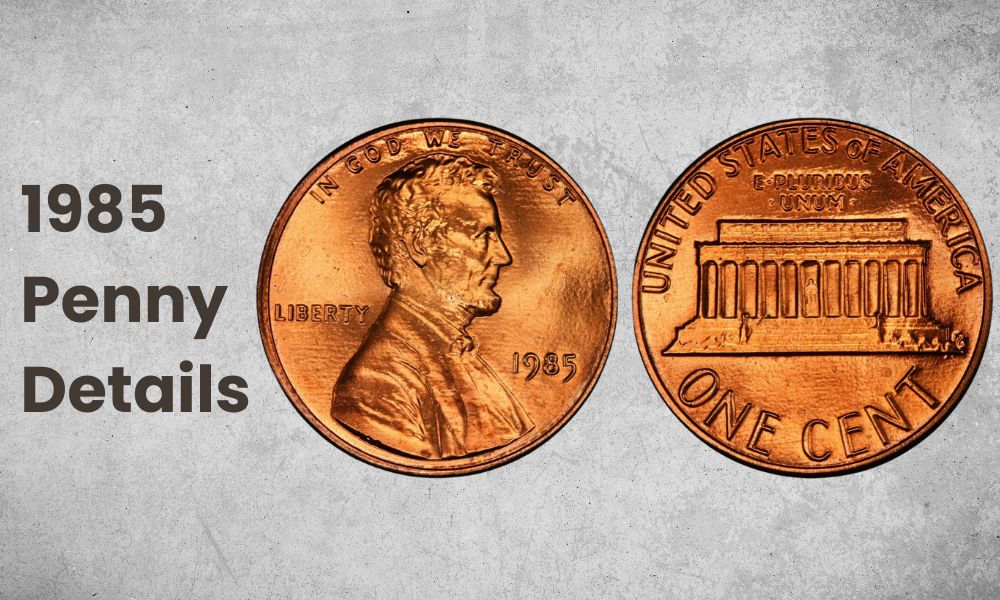
- Category: Lincoln Penny
- Mints: Philadelphia, Denver, San Francisco
- Total Mintage: Over10,939,252,634
- Obverse designer: Victor David Brenner
- Reverse designer: Frank Gasparro
- Edge: Plain
- Diameter: 19 mm
- Thickness: 52 mm
- Composition: Zinc (97.5%), Copper (2.5%)
- Weight: 5 grams
- Face Value: $0.01
1985 pennies are part of the Lincoln series, one of the most recognizable coins worldwide. Featuring one of the most well-known US presidents, Abraham Lincon, the penny debuted back in 1909. Its obverse side was designed by Victor David Brenner and has remained part of the coin throughout its many redesigns.
The reverse side of the coin was initially a simplistic picture of wheat. In 1959, however, the reverse was redesigned to celebrate the President’s 150th birthday anniversary.
This design, which continued through 1985, features the Lincoln Memorial along with the text ‘United States of America’ and the ‘e Pluribus Unum’ (meaning out of many, one). The reverse side of the penny was only redesigned in 2008 to mark the Lincoln Bicentennial One Cent Program.
Features of 1985 are pretty similar to other pennies around that time. Because of their low face value, pennies had no unique ridges or edging that would usually protect them from counterfeiting.
Before 1982, pennies were mainly copper. But in the 80s, rising inflation and the high cost of copper meant that production costs were much higher than the penny’s weak value. As such, the US Mint changed the composition to reduce costs.
As such, the 1985 penny contains 97.5% zinc, with only 2.5% copper added to plate it. These changes made the coin much lighter than previous pennies, weighing just 2.5 grams.
The lower production costs meant coin production could continue in Denver, Philadelphia, and San Francisco. Altogether, over 10.9 billion pennies were made in 1985, meaning there is potentially still a considerable amount in circulation today. For this reason, the pennies themselves aren’t deemed too valuable.
But don’t throw out your penny just yet. Like any collectible, there are exceptions to these rules. Some 1985 pennies have sold for hundreds, if not thousands, of dollars at auction.
Also Read: Top 20 Most Valuable Old Pennies Worth Money (Penny Collection)
Value chart
1985 Penny Value Chart |
||||
| Mint Mark | Good | Fine | Extremely Fine | Uncirculated |
| 1985 No Mint Penny | $0.01 | $0.01 | $0.01 | $0.30+ |
| 1985 D Penny | $0.01 | $0.01 | $0.34 | $0.34+ |
| 1985 S Penny | $0.01 | $0.01 | $0.01 | $5.50+ |
The only valuable 1985 pennies are those with uncirculated or higher quality. Additionally, if they have unique errors, this will set them apart from otherwise generic coins on sale.
Below is a quick guide to the four most common value categories:
- Good –the coin is worn and damaged, with basic details like the date and type legible. Finer details are missing.
- Fine – the coin has crisper details and readable lettering but still has noticeable wear and tear and worn-out parts of the design and edging.
- Extremely fine – the coin has maintained some impressive details on its raised surface but can only be seen through a magnifying glass. It has little signs of use.
- Uncirculated – this coin is among the best-preserved coins, with little to no signs of use, blemishes, markings, and retaining at least half of its original sheen.
1985 Penny Value and Varieties Guides
There are three variations to the 1985 penny that you can collect. They are:
1985 No Mint Penny value
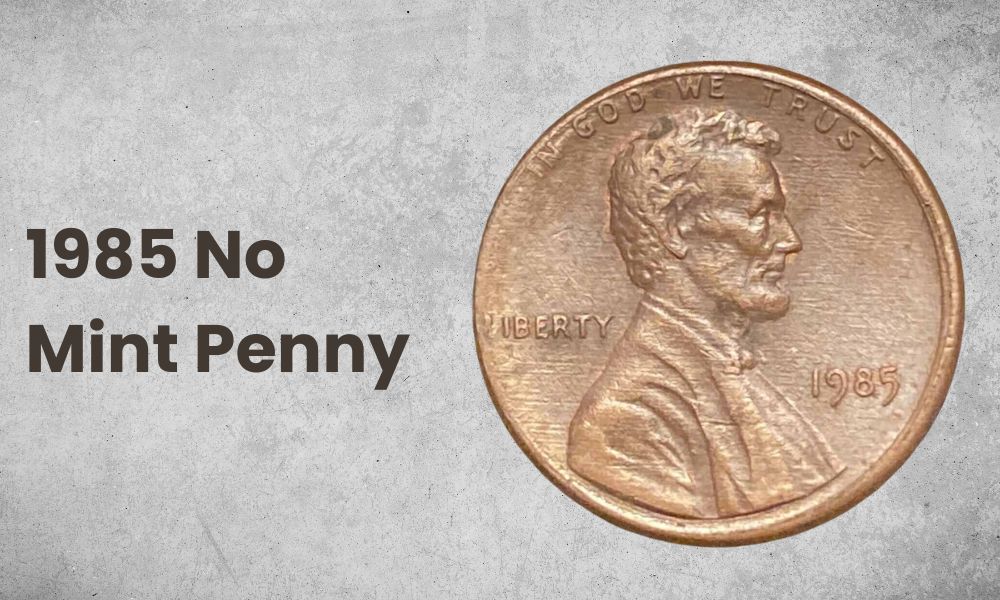
- Type: Lincoln Penny
- Edge: Plain
- Mint mark: No mint mark
- Place of minting: Philadelphia
- Year of minting: 1985
- Face value: $0.01
- $ Price: $0.01 – $0.30+
- Quantity produced: 5,648,489,887
- Designer: Victor David Brenner & Frank Gasparro
- Composition: Zinc (97.5%), Copper (2.5%)
- Mass: 5 grams
The first variation of coins is the no-mint 1985 penny. Coins with no mint mark are almost always sourced back to Philadelphia.
Records state that Philadelphia produced the most significant number of coins, at an unprecedented number of 5.6 billion. That means that many of these pennies are still in circulation today. As such, they generally aren’t worth more than their face value of 1c.
That said, an uncirculated penny can still be worth some money, starting from 30 cents to nine dollars, with some unique coins valued in the thousands/
A no-mint 1985 penny broke many records when it sold for $5,875 in 2017. The reason? The coin was described as “virtually flawless” when examined under a microscope.
1985 D Penny value
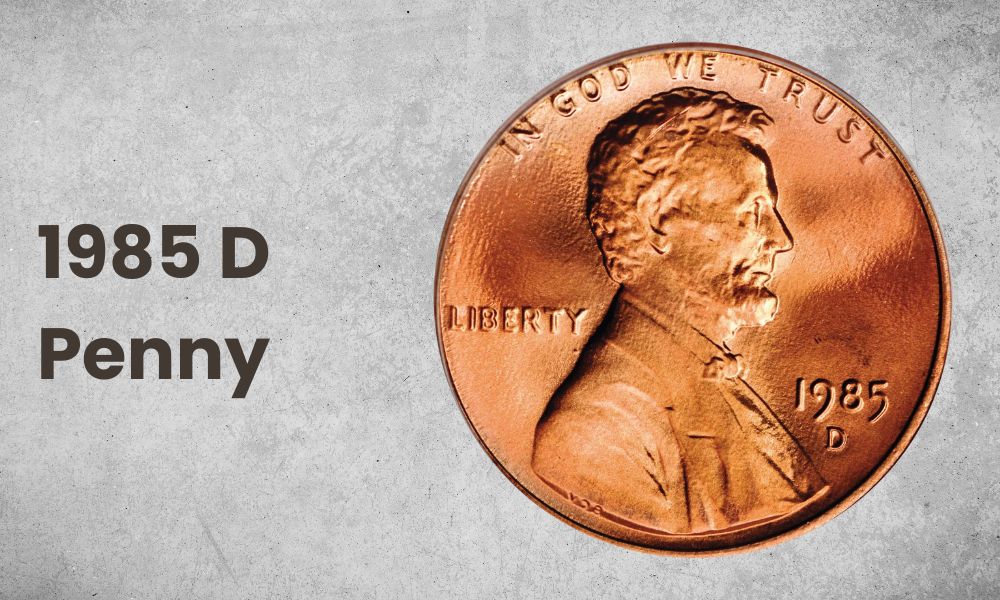
- Type: Lincoln Penny
- Edge: Plain
- Mint mark: No mint mark
- Place of minting: Denver
- Year of minting: 1985
- Face value: $0.01
- $ Price: $0.01 – $0.34+
- Quantity produced: 5,287,399,926
- Designer: Victor David Brenner & Frank Gasparro
- Composition: Zinc (97.5%), Copper (2.5%)
- Mass: 5 grams
The Denver mint produced over 5 billion 1985 pennies, making it an incredibly easy coin to come across. You will recognize these coins with the signature Denver mint mark “D” on the obverse side.
While there is no real shortage of 1985 D pennies, it is generally considered more valuable than the no-mint variation because of its ties to Denver. Additionally, the mint mark opens up for more variations and errors with coins, adding more value.
Some unique 1985 D pennies have broken auction records in the past, and it’s something to remember as you examine your coin. A 1985 D penny sold for $3,120 in 2018, with the listing citing It as having a full strike during minting and being in “unsurpassed quality.”
Another record-breaking 1985 D penny sold for $5,635 in 2010 because it had zero blemishes and high luster.
1985 S Penny
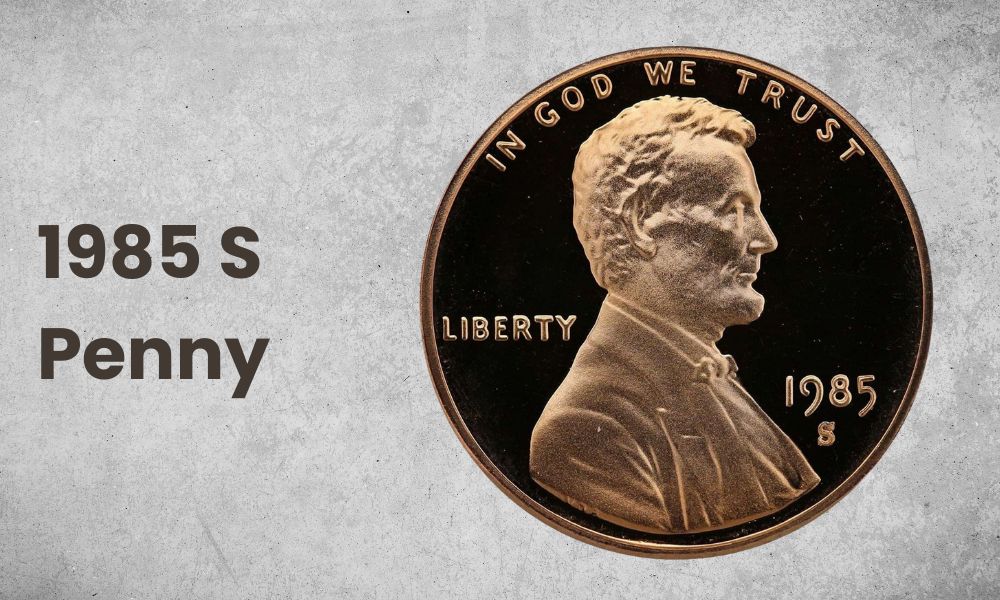
- Type: Lincoln Penny
- Edge: Plain
- Mint mark: No mint mark
- Place of minting: Philadelphia
- Year of minting: 1985
- Face value: $0.01
- $ Price: $5.84+
- Quantity produced: 3,362,821
- Designer: Victor David Brenner & Frank Gasparro
- Composition: Zinc (97.5%), Copper (2.5%)
- Mass: 5 grams
The last variation of the 1985 penny is the S penny, minted in San Francisco. Like other pennies in the Lincoln series, the San Francisco mint produced a tiny number, making them much less common than the different variations and potentially much more valuable at auction.
With just over 3 million pennies in circulation, a 1985 S penny can quickly get you over $5.84+. Despite their rarer status, they haven’t sold as well on public auctions. The highest 1985 S penny sold was $1,610 in 2016. A potential explanation may be that not many S pennies are of high quality.
1985 Penny History
The 1985 penny belongs to the iconic Lincoln memorial coin series. Dedicated after the 16th President of the United States, the penny has a rich history dating back to 1909.
This was when the first coins were issued. Lithuanian sculptor and engraver Victor David Brenner designed the obverse side. It depicts a profile portrait of Lincoln, with the simple text ‘In God we Trust’ and ‘Liberty’ engraved. This design has survived every reissue of the penny.
The reverse side has changed somewhat throughout the years. Initially, the Lincoln penny had a simplistic ‘Wheat’ design, with two shafts of wheat and the words ‘United States of America.’
In 1959, to celebrate Lincoln’s 150th birthday anniversary, the US Mint opened a competition for a new reverse design. Engraver Frank Gasparro eventually won the contest, which featured the Lincoln memorial. This design is the signature back of the 1985 penny and continued to be used until the 2008 penny redesign.
While pennies were originally made of copper, the US economy heavily influenced the coin’s composition. In World War 2, for example, pennies were temporarily made of zinc-coated steel, as copper was a vital resource for the war effort.
In the 1980s, rising inflation and copper prices meant it was becoming too expensive to make low-value coins, like pennies, out of copper. As such, the US Mint changed the composition to 97.5% zinc and only 2.75% copper. This made producing pennies like the 1985 penny much more affordable.
There were three places the 1985 penny was minted; Denver and Philadelphia produced most of the coins, many of which are still in circulation today. While San Francisco minted 1985 pennies, they were made in such small numbers that they don’t frequently appear at auction.
1985 Penny Grading
So how do you work out the value of your 1985 penny? Coins follow a grading system that considers everything, from luster (sheen), quality, and condition, to errors and rarity on the market.
Below is a straightforward guide on how you can grade the value of your penny:
List of 1985 Penny Errors
Because of their low value and sheer production numbers, there wasn’t always stringent quality control. Mistakes happened regularly. And while this might make the penny look worthless, it can increase its value tenfold.
Below are some common 1985 errors:
1. 1985 Planchet Penny Error
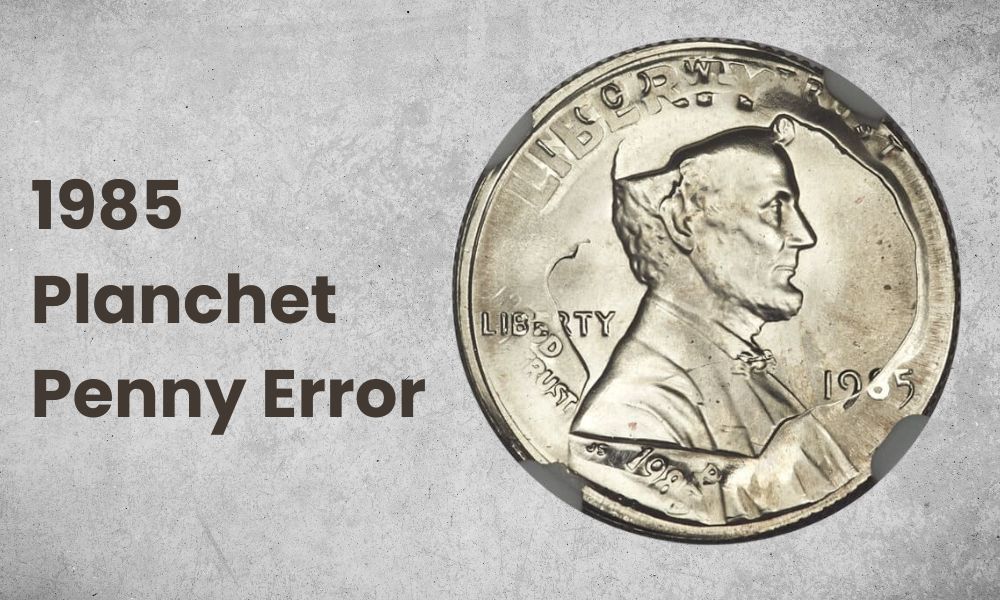
A planchet error is when someone uses the wrong stamp on a coin, e.g., a Lincoln design on a dime. The value of this error can depend on the type of coins involved, the extent of the error, and the coin’s condition. This 1985 penny, for example, was stamped on a dime coin and is worth over $747.50.
This 1985 cent has a two-planchet bonded error, meaning two cent coins were fused for a unique strike. The asking price on this active auction is $1,322, suggesting it is precious.
2. 1985 Off-Center Penny Errors
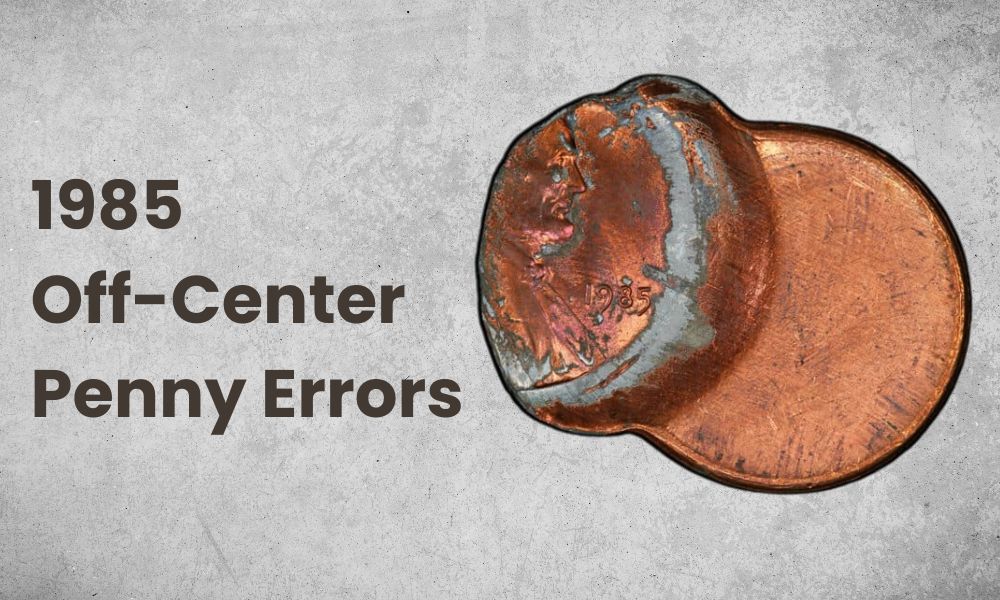
Off-center errors are prevalent in coin production. It is when, during production, someone uses the wrong angle during striking. The design appears slanted or partially off the coin.
The value depends on the extent of the off-center and the coin’s overall condition. This 1985 Lincoln coin has a 75% stretched off-center, worth up to $79 at auction.
3. 1985 Partial Plating Error
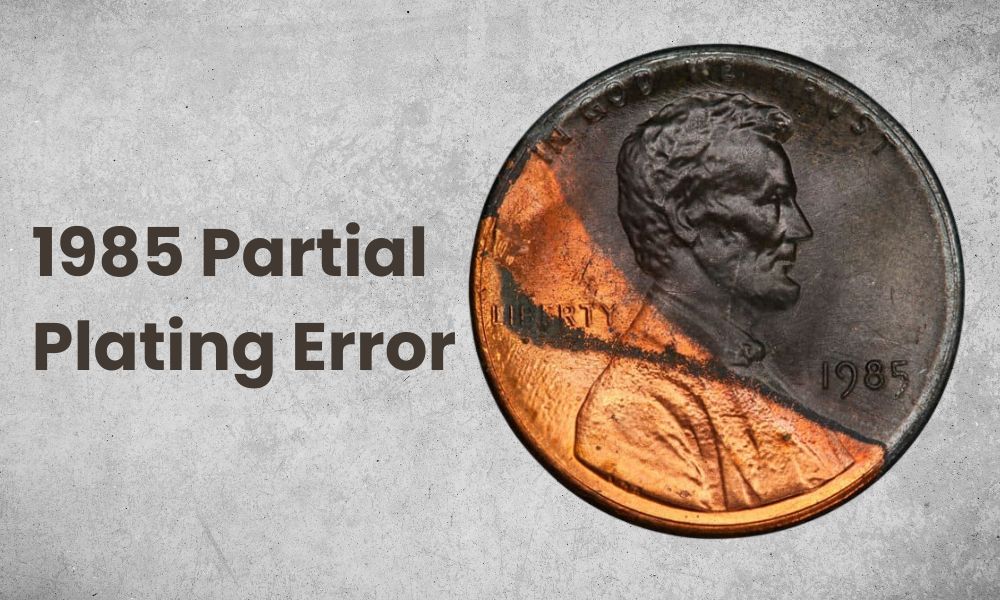
Because the 1985 penny was made primarily of zinc, but with copper plating, this opened up the coin to being improperly coated during production.
An incomplete coating could create unique patterns and colors throughout the coin. As such, they can be quite popular among collectors for their exclusive appearance. For example, this 1985 penny sold for an impressive $552 in 2021.
4. 1985 Penny die error
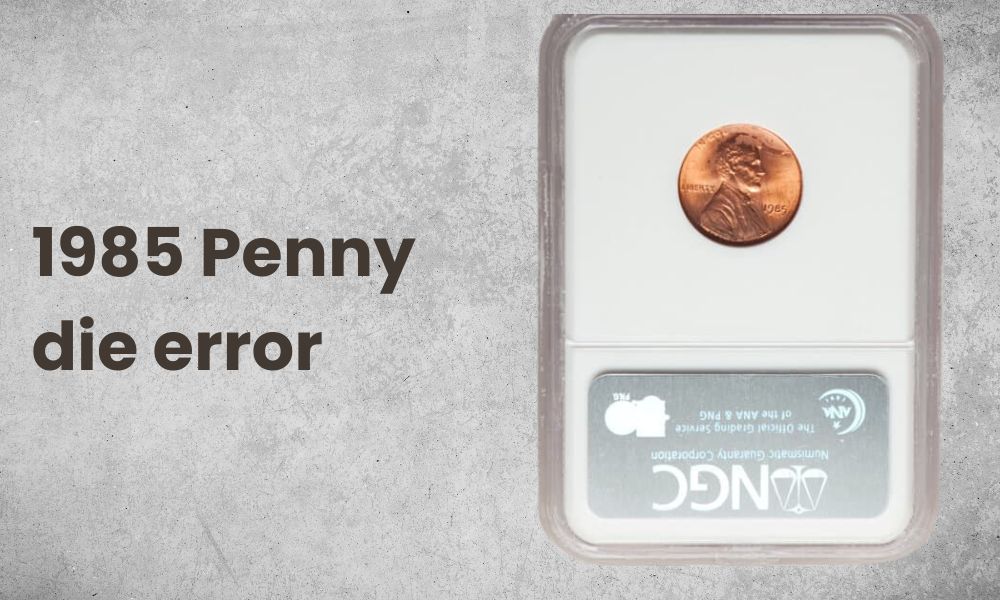
Each year, billions of pennies are produced. Dies and other equipment frequently breaks during production. These coins will have some mark or damaged design that might initially make them seem worthless.
But these errors are a unique feature many collectors are interested in owning. Prices vary depending on the severity of the error. But this 1985 penny with reverse die break sold for $144 in 2021, showing you an idea of the value they can fetch.
1985 Penny Value FAQ
What is the melting value of a 1985 penny?
As 1985 pennies are mainly zinc, they have a lower melting value than their actual face value in today’s market. As such, a penny has a melt value of just $0.0077.
What makes the 1985 penny rare?
While errors usually make a coin incredibly rare, the most expensive and valuable 1985 coins are often high-grade with no tarnish or blemishes.
If you want the rarest penny, forget about errors and faults, and focus more on its quality, shimmer, colors, and overall condition.
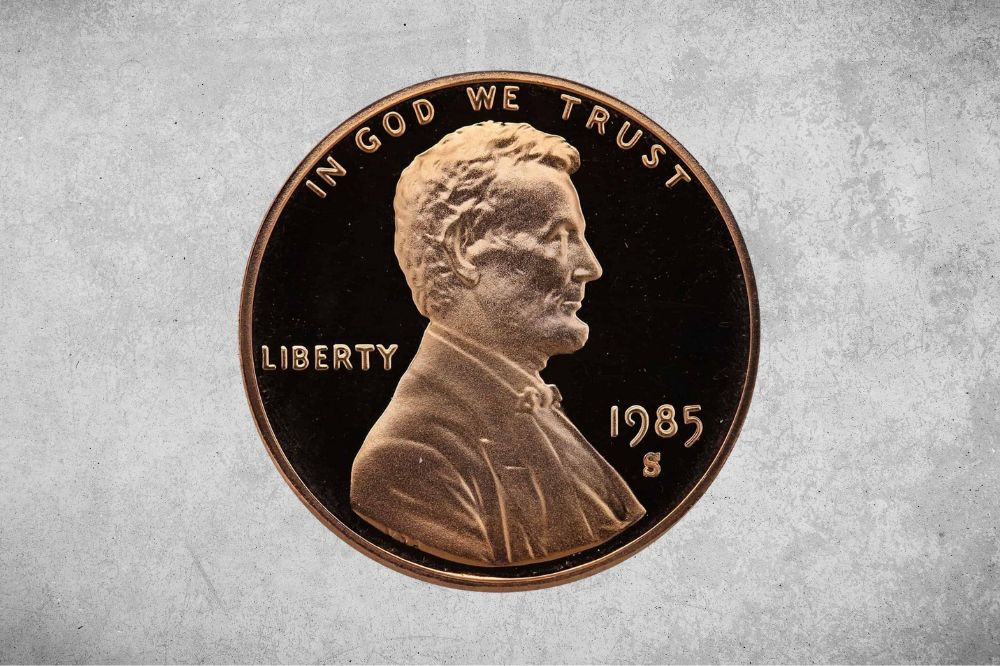
Hello, this is in regards to a 1985 D penny. I had found this penny with a curve in the lower right side of the (R) in E PLURIBUS UNUM. I have been unsuccessful in finding this as an error however maybe this could be a new variety and was hoping I could get some insight on this. Thank you for the information that is posted it is very helpful on every coin that I have researched.